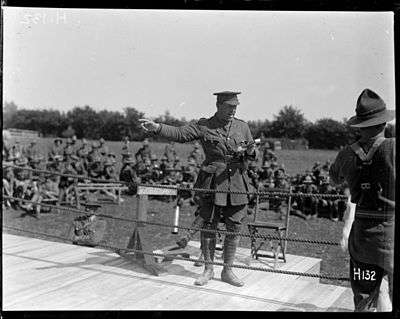Arthur Plugge
| Lieutenant Colonel Arthur Plugge CMG | |
|---|---|
| Born |
17 February 1877 Hull, United Kingdom |
| Died |
2 July 1934 (aged 57) Taupiri, New Zealand |
| Allegiance |
|
| Service/ |
|
| Rank | Lieutenant Colonel |
| Commands held | Auckland Infantry Battalion |
| Battles/wars | |
| Awards |
Order of St Michael and St George Mentioned in Dispatches (2) |
Lieutenant Colonel Arthur Plugge, CMG (17 February 1877 – 2 July 1934), was an English-born officer who served during World War I with the New Zealand Military Forces. As commanding officer of the Auckland Infantry Battalion of the New Zealand Expeditionary Force, he was among the first New Zealanders to land at Gallipoli on 25 April 1915. Plugge's Plateau Commonwealth War Graves Commission Cemetery is located on the hilltop where he established his headquarters on the day of the Gallipoli landing.
Early life
Plugge was born in Hull, England on 18 February 1877. Educated at Elmfield College in York, he subsequently attended Leeds University.[1] Emigrating to New Zealand in 1899, he taught science at Kings College in Auckland.[2] He was headmaster at another Auckland school, Dilworth Ulster Institute, from 1909 until 1914.[3] He was actively involved in the Territorial Force, serving with the 3rd Auckland Regiment.[4]
Military career
Following the outbreak of World War I, Plugge volunteered for the New Zealand Expeditionary Force (NZEF). A major in the Territorial Force, he was promoted to lieutenant colonel and placed in command of the Auckland Infantry Battalion, which was formed from one company each of four territorial regiments and had the first serial number, 12/1, on its roll.[3] He was not particularly popular as a commander, being regarded as an amiable but weak leader, and reportedly favoured the company drawn from his territorial regiment.[4]

Gallipoli
Plugge's battalion arrived in Egypt on 3 December 1914 and from there were the first New Zealand troops to land at ANZAC Cove on 25 April 1915. Upon landing, Plugge positioned his battalion headquarters at the top of a hill just inshore from the Cove. The hill was consequently given the name Plugge's Plateau by the invading troops, and after the war, Plugge's Plateau Commonwealth War Graves Commission Cemetery was established on the hilltop. During the day's action, Plugge was lightly wounded in the wrist by a shell fragment. He was wounded again a few weeks later on 8 May, during the Second Battle of Krithia.[5]
Plugge was evacuated to Malta for medical treatment, and here he contracted malaria which necessitated his transfer to England for treatment.[1] After recovering his health, he was returned to his command in Gallipoli, leading his battalion during the evacuation from the peninsula. He was mentioned in despatches and appointed to the Order of St Michael and St George in October 1915, for his services during the Gallipoli campaign.[6]
Western Front
When the New Zealand Division was being formed in Egypt following the conclusion of the Gallipoli Campaign, Plugge was made commander of the 1st Auckland Infantry Battalion, which was part of the 1st New Zealand Infantry Brigade.[7] He went on to lead his battalion during the Battle of the Somme. In December 1916, following a reorganisation of the division, he was removed from his command by the divisional commander, Major General Andrew Russell. This was partly due to dissatisfaction with Plugge's performance,[8] and was also an attempt to address a high desertion rate amongst his battalion.[9] In light of his Gallipoli service, Plugge was not returned to New Zealand. Instead, he was allowed to remain with the division as its sports coordinator. It transpired that this was a role in which he excelled,[8] and he remained in the position until he was discharged from the NZEF on 18 June 1918.[10]
Later life
On his return to New Zealand, Plugge took up dairy farming at Taupiri, near Huntly. He also maintained an involvement with the School Cadet Corps and the Boy Scouts. He died on 2 July 1934 at the age of 57 and was buried in Taupiri Cemetery with military honours. He was survived by his wife, Millicent, and three children. A son, John, had been killed in a flying accident with the Royal Air Force just two months earlier.[1]
Notes
- 1 2 3 "Obituary". The Waikato Times. 3 July 1934.
- ↑ Pugsley 1984, p. 380.
- 1 2 "Lieutenant Colonel Arthur Plugge". Auckland War Memorial Museum Cenotaph Database. Retrieved 1 August 2008.
- 1 2 Pugsley 1984, p. 73.
- ↑ Pugsley 1984, p. 198.
- ↑ Waite 1919, p. 309.
- ↑ Stewart 1921, p. 15.
- 1 2 Pugsley 1991, p. 321.
- ↑ Pugsley 1991, p. 170.
- ↑ "Arthur Plugge military personnel file". Archives New Zealand. Retrieved 17 April 2012.
References
- Pugsley, Christopher (1984). Gallipoli: The New Zealand Story. Auckland, New Zealand: Hodder & Stoughton. ISBN 0-340-338776.
- Pugsley, Christopher (1991). On the Fringe of Hell: New Zealanders and Military Discipline in the First World War. Auckland, New Zealand: Hodder & Stoughton. ISBN 0-340-53321-8.
- Stewart, H. (1921). The New Zealand Division 1916 – 1919: A Popular History Based on Official Records. Official History of New Zealand's Effort in the Great War. Auckland, New Zealand: Whitcombe & Tombs. OCLC 2276057.
- Waite, Fred (1919). The New Zealanders at Gallipoli. Official History of New Zealand's Effort in the Great War. Auckland, New Zealand: Whitcombe & Tombs. OCLC 6268942.